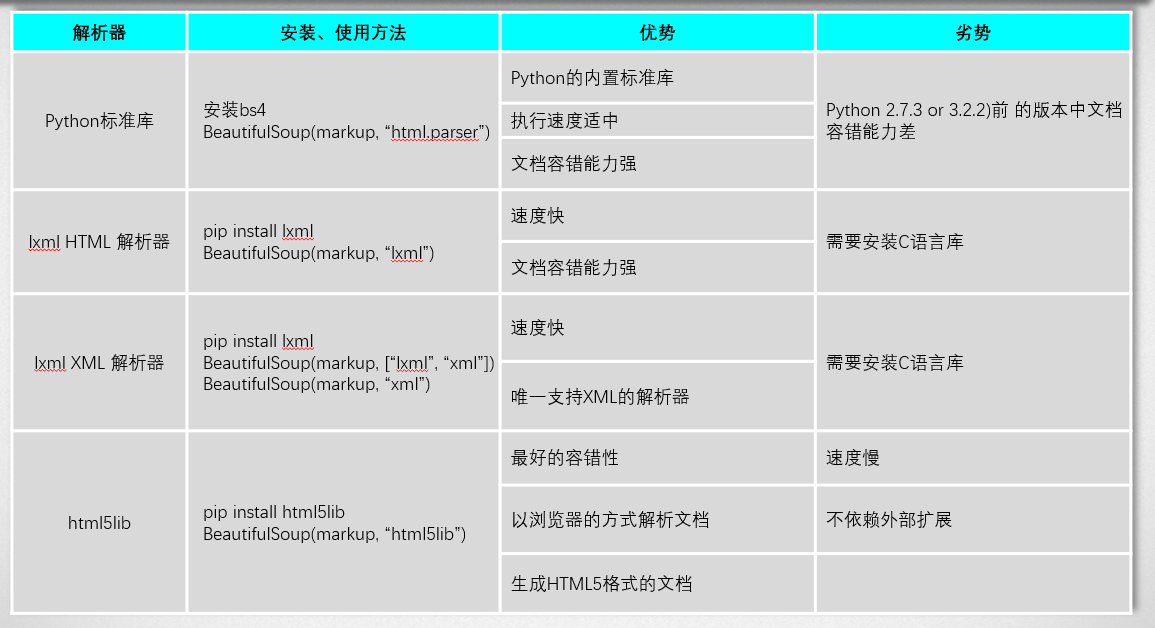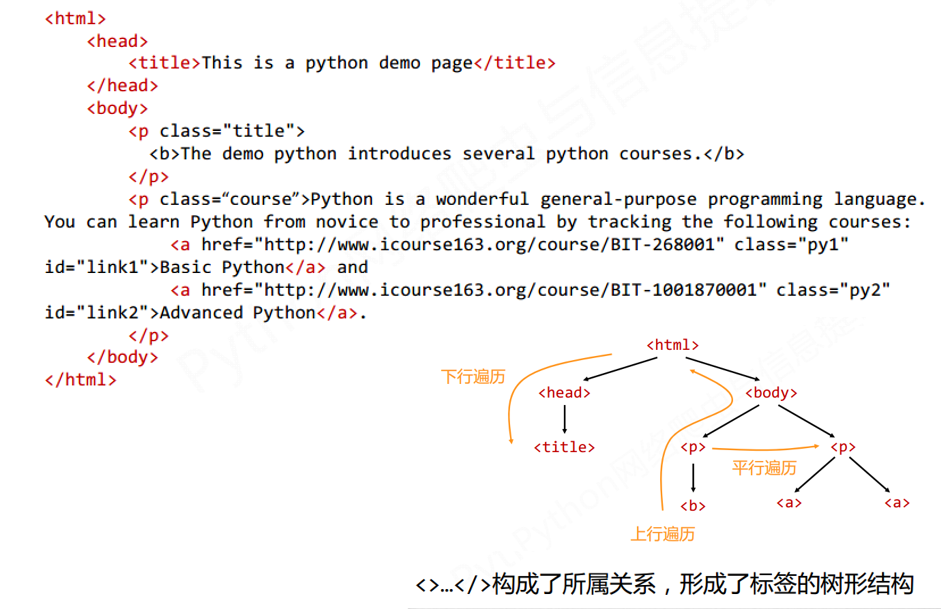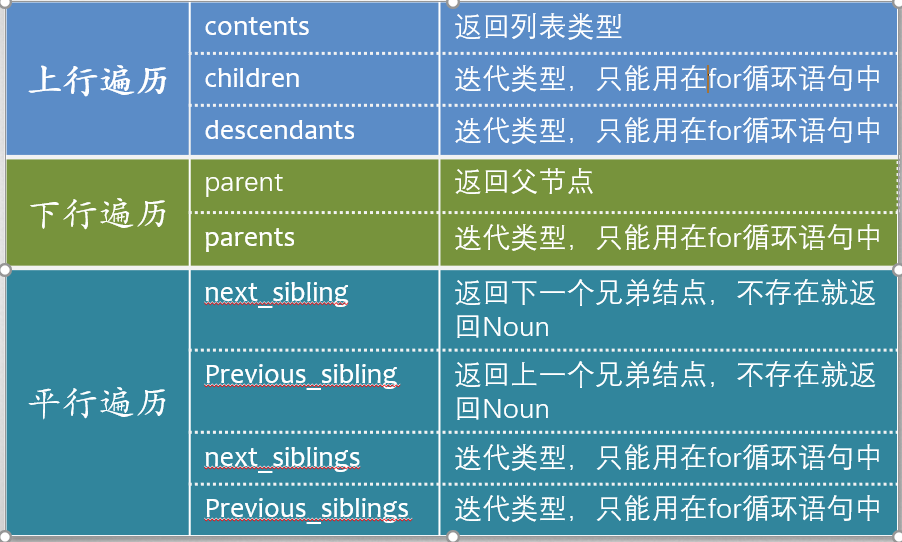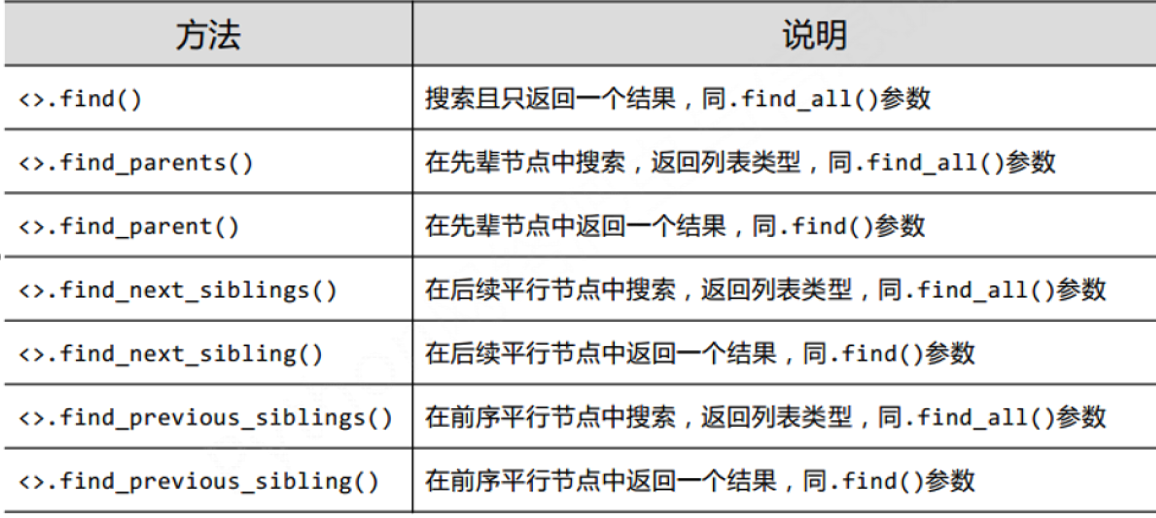title: 爬虫入门二 beautifulsoup
date: 2020-03-12 14:43:00
categories: python
tags: crawler
使用beautifulsoup解析数据
1 beautifulsoup简介
BeautifulSoup 是一个可以从HTML或XML文件中提取数据的Python库.它能够通过转换器实现文档导航、查找、修改。
pip install beautifulsoup4
http://beautifulsoup.readthedocs.io/zh_CN/latest/
2 前端知识
HTTP:HyperText Markup Language 超文本标记语言
CSS:Cascading Style Sheets 层叠样式表
JAVASCRIPT:一种脚本语言,其源代码在发往客户端运行之前不需经过编译,而是将文本格式的字符代码发送给浏览器由浏览器解释运行
XML:Extensible Markup Language可扩展标记语言
XML是被设计用来描述数据的,HTML是被设计用来显示数据的。与HTML相比,XML支持动态更新,标准性更强
3 beautifulsoup解析器
比如BeautifulSoup(demo, 'html.parser') 中的html.parser

4 html结构
<></>构成所属关系。树形结构。下行,上行,平行遍历。

5 使用beautifulsoup解析HTML
注意B和S大写,Python对大小写敏感
from bs4 import BeautifulSoup
import requests
def html():
# 得到未解析的HTML网页内容
r = requests.get("https://whu.edu.cn/coremail/common/index_cm40.jsp")
print(r.text)
# 得到解析的HTML网页内容
demo = r.text
soup = BeautifulSoup(demo, 'html.parser')
print(soup.prettify())
6 BeautifulSoup 类的基本元素与操作
Tag,标签<></>开始结束
name,标签名,
的name是p。
attributes,标签属性(字典形式组织)。
navigablestring,标签内非属性字符串.
comment,标签内字符串的注释部分
下面是例子:
可以看到,web中有很多a标签,,而这里只返回了第一个
from bs4 import BeautifulSoup
import requests
def html():
# 得到未解析的HTML网页内容
r = requests.get("https://whu.edu.cn/coremail/common/index_cm40.jsp")
print(r.text)
# 得到解析的HTML网页内容
demo = r.text
soup = BeautifulSoup(demo, 'html.parser')
#print(soup.prettify())
print(soup.title)
print(soup.a)
#<title>武汉大学邮件系统</title>
#<a class="MTLinks">设为首页</a>
HTML中a锚文本A超链接标签格式: 被链接内容
6.1 BeautifulSoup标签操作
#查看标签a的属性
tag=soup.a
tag.attrs
#查看标签a的属性中class的值
tag.attrs['class']
#查看标签a的属性 的类型
type(tag.attrs)
#查看标签a的非属性字符串
soup.a.string
#查看标签a的非属性字符串属性 的类型
type(tag.a.string)
#返回值为bs4.element.NavigableString (可以遍历的字符串)
from bs4 import BeautifulSoup
import requests
def html():
# 得到未解析的HTML网页内容
r = requests.get("https://whu.edu.cn/coremail/common/index_cm40.jsp")
print(r.text)
# 得到解析的HTML网页内容
demo = r.text
soup = BeautifulSoup(demo, 'html.parser')
#print(soup.prettify())
print(soup.title)
print(soup.a)
# 查看标签a的属性
tag = soup.a
print(tag.attrs)
# 查看标签a的属性中class的值
tag.attrs['class']
# 查看标签a的属性 的类型
print(type(tag.attrs))
# 查看标签a的非属性字符串
print(tag.string)
# 查看标签a的非属性字符串属性 的类型
print(type(tag.string))
# 返回值为bs4.element.NavigableString (可以遍历的字符串)
7 html遍历
上行,下行,平行。

7.1 标签树下行遍历 .content .children .descendants
7.1.1 .content
.contents 子节点的列表,将
soup.body.contents
#获得孩子节点的个数
len(soup.body.contents)
#分别输出各个子节点
soup.body.contents[0]
soup.body.contents[2]
#标号 由0开始
7.1.2 .children/.descendants
.contents 和 .children 属性仅包含tag的直接子节点,.descendants 属性可以对所有tag的子孙节点进行递归循环
需要遍历获取其中的内容。
for child in soup.body.children:
print(child)
for child in soup.body.descendants:
print(child)
def htmlergodic():
# 得到未解析的HTML网页内容
r = requests.get("https://whu.edu.cn/coremail/common/index_cm40.jsp")
#print(r.text)
# 得到解析的HTML网页内容
demo = r.text
soup = BeautifulSoup(demo, 'html.parser')
# 子节点的列表,将<tag>所有儿子节点存入列表
#print(soup.body.contents)
# 获得孩子节点的个数
print(len(soup.body.contents))
# 分别输出各个子节点
print(soup.body.contents[0])
print(soup.body.contents[2])
# 标号 由0开始
for child in soup.body.children:
print(child)
for child in soup.body.descendants:
print(child)
7.2 标签树上行遍历 .parent/.parents
# a的父节点
soup.a.parent.name
# 遍历
for parent in soup.a.parents: #注意 s
print(parent.name)
7.3 标签树平行遍历 next_sibling/Previous_sibling
#获得a节点的上一个节点和下一个节点
soup.a.next_sibling
soup.a.previous_sibling
for sibling in soup.a.next_siblings: #注意s
print(sibling)
8 bs4的库的prettify()方法
BeautifulSoup 是bs4库的类,prettify()是方法。
.prettify()为HTML文本<>及其内容增加换行符
可以用于整个HTML文本,也可以用于单个标签
方法:
bs4库将任何HTML输入都变成utf‐8编码 Python 3.x默认支持编码是utf‐8,解析无障碍
print(soup.body.prettify())
9 BeautifulSoup信息检索 注意find标签名要加''表示字符串
9.1 .find_all() 搜索并返回全部结果
<>.find_all(name,attrs,recursive,string,**kwargs)
def jiansuo():
r = requests.get("http://www.baidu.com/")
r.encoding = r.apparent_encoding
demo = r.text
soup = BeautifulSoup(demo, 'html.parser')
print(soup.find_all('a'))
9.2 参数
name: 对标签名称的检索字符串
attrs: 对标签属性值的检索字符串,可标注属性检索
recursive: 是否对子孙全部检索,默认True
string: <>…</>中字符串区域的检索字符串
#搜索 class=“mnav” 的全部a标签
print(soup.find_all('a','mnav'))
# 搜索字符串为新闻的全部标签
print(soup.find_all(string='新闻'))
如果要部分匹配,则需要导入正则表达式库
9.3 扩展方法
<>.find()
<>.find_parents()
<>.find_parent()
<>.find_next_sibling()
<>.find_next_siblings()
<>.find_previous_sibling()
<>.find_previous_siblings()

10 实例
10.1 爬取武汉大学官方网站,含'樱'的新闻链接标题
导入requests库、BeautifulSoup类、re库
使用for循环,查找条件string=re.compile('樱'))
搜索类型为新闻链接,因此类型为‘a’
输出满足条件的tag的字符串
import re
import requests
from bs4 import BeautifulSoup
def sakura():
r = requests.get("http://www.whu.edu.cn/")
r.encoding = r.apparent_encoding
demo = r.text
soup = BeautifulSoup(demo,'html.parser')
for tag in soup.find_all('a', string=re.compile('樱')):
print(tag.string)
10.2 爬取 百度互联网热门人物排行
访问百度搜索风云榜
人物--互联网人物
http://top.baidu.com/buzz?b=257&c=9&fr=topcategory_c9
右键点击 “马云”--检查,查看对应的HTML代码
<a class="list-title" target="_blank" href="http://www.baidu.com/baidu?cl=3&tn=SE_baiduhomet8_jmjb7mjw&rsv_dl=fyb_top&fr=top1000&wd=%C2%ED%D4%C6" href_top="./detail?b=257&c=9&w=%C2%ED%D4%C6">马云</a>
分析可知人物连接标签名为a,class为list-title
使用soup.find_all(‘a’, ‘list-title’ ) 输出class为list-title
的a标签的字符串,即可书序得到排行榜的人物名单。
同时在前面加上他们索引序号index(tag.string)+1
即可得到今日互联网人物排行榜
def fyrw():
r=requests.get("http://top.baidu.com/buzz?b=257&fr=topboards")
r.encoding=r.apparent_encoding
demo=r.text
soup=BeautifulSoup(demo, 'html.parser')
ulist = []
for tag in soup.find_all('a', 'list-title' ):
ulist.append(tag.string)
print(ulist.index(tag.string)+1,ulist[ulist.index(tag.string)])
10.3 爬取 中国大学排行榜2016
从网络上获取大学排名网页内容
getHTMLText()
提取网页内容中信息到合适的数据结构
fillUnivList()
利用数据结构展示并输出结果
printUnivList()
http://www.zuihaodaxue.cn/zuihaodaxuepaiming2016.html
检查网页代码看到结构是
<tbody>
<tr>
<td> 排位
<td> 大学名...
<tr>
...
这样就遍历标签的每个标签,提取前三个标签的string保存即可
def getHTMLText(url):
try:
r = requests.get(url, timeout=30)
r.raise_for_status()
r.encoding = r.apparent_encoding
return r.text
except:
return ""
def fillUnivList(ulist, html):
soup = BeautifulSoup(html, "html.parser")
for tr in soup.find('tbody').children: #提取tbody的每个tr标签
if isinstance(tr,bs4.element.Tag): #判断tr是否是tag类型
tds = tr('td') #tds[0] <td>1</td>.简写,等价于下一行代码
#tds = tr.find_all('td')
# ,然后用.string取string
ulist.append([tds[0].string, tds[1].string, tds[3].string])
def printUnivList(ulist, num):
print("{:^10} {:^6} {:^10}".format("排名", "学校名称", "总分"))
for i in range(num):
u = ulist[i]
print("{:^10} {:^6} {:^10}".format(u[0], u[1], u[2]))
def main():
uinfo = []
url = 'http://www.zuihaodaxue.cn/zuihaodaxuepaiming2016.html'
html = getHTMLText(url)
fillUnivList(uinfo, html)
printUnivList(uinfo, 20) # 20 univs
上面的问题是并没有对齐。
原因是当中文字符宽度不够时,采用西文字符填充;中西文字符占用宽度不同。
解决是采用中文字符的空格填充chr(12288)
def printUnivList(ulist, num):
tplt = "{0:^4} {1:{3}^12} {2:^10}"
print(tplt.format("排名", "学校名称", "总分", chr(12288)))
for i in range(num):
u = ulist[i]
print(tplt.format(u[0], u[1], u[2], chr(12288)))
tplt为定义的输出格式模板变量,^代表居中,4/12/10代表输出宽度(当输出数据超过该数字时,以实际输出为准),
{3}代表打印输出时,我们使用format中的第3个变量(由0起始),也就是 chr(12288)
chr(12288)代表全角Unicode空格(即中文空格)
# :是引导符号
# : <填充><对齐><宽度>,<精度><类型> 这里的 ','是千位分隔符
# 拿上面的代码举例
#tply:0,1,2对应输出的第0,1,2个数据。^表示居中,然后第0个数据宽4.中间{3}表示填充用format第3个变量也就是chr(12288)
10.4 最好大学2017.遇坑
同样的代码爬
http://www.zuihaodaxue.cn/zuihaodaxuepaiming2017.html
报错
TypeError: unsupported format string passed to NoneType.format
#2016
<tr class="alt"><td>1</td>
<td><div align="left">清华大学</div></td>
#2017
<tr class="alt"><td>1<td><div align="left">清华大学</div></
注意这里有坑,chrome检查,在console看到是没区别的(2017也是1)
检查页面源代码发现和2016比不同之处在于子节点“1”所对应的地方并非是一个完整的子节点,“1”并没有被一对完整的标签所包围,所以tds[0]实际上是被第一个标签所包围的所有内容,而这相当于把后续所有内容全给装进去了。
由于字符1仍是第一的标签下的第一个子节点,通过bs4库的contents方法来获得这个排名,由于是第一个子节点,tds[0].contents[0]就排名。
重新修改的代码如下
def fillUnivList(ulist, html):
soup = BeautifulSoup(html, "html.parser")
for tr in soup.find('tbody').children: #提取tbody的每个tr标签
if isinstance(tr,bs4.element.Tag): #判断tr是否是tag类型
tds = tr('td') #tds[0] <td>1</td>.简写,等价于下一行代码
#tds = tr.find_all('td')
# ,然后用.string取string
ulist.append([tds[0].contents[0].string, tds[1].string, tds[3].string])
10.5 2016世界大学排名,遇坑
http://www.zuihaodaxue.cn/ARWU2016.html
先用了2016中国排名的方法,然后报错,然后看源码,没看出来不同。
就把爬的内容打印一下
发现大学名字打印的是none
然后对比2016中国和2016大学.
<td class="align-left">
<a href="World-University-Rankings/Harvard-University.html" target="_blank">哈佛大学</a>
</td>
<td><div align="left">清华大学</div></td>
不明白就去查,
https://blog.csdn.net/github_36669230/article/details/66973617
用 .string 属性来提取标签里的内容时,该标签应该是只有单个节点的。比如上面的 1 标签那样。也就是说世界大学的标签影响了
那就直接提取.string就行了
def fillUnivList(ulist, html):
soup = BeautifulSoup(html, "html.parser")
for tr in soup.find('tbody').children: #提取tbody的每个tr标签
if isinstance(tr,bs4.element.Tag): #判断tr是否是tag类型
tds = tr('td') #tds[0] <td>1</td>.简写,等价于下一行代码
#tds = tr.find_all('td')
# ,然后用.string取string
tmp=tds[1].find('a')
#print(tds[0].string, tmp.string, tds[3].string)
ulist.append([tds[0].string, tmp.string, tds[3].string])
11 相关网站
0.北理工课程
https://www.bilibili.com/video/av9784617?from=search&seid=12715531491861423376
1.廖雪峰官方网站
http://www.liaoxuefeng.com/wiki/0014316089557264a6b348958f449949df42a6d3a2e542c000
2.Python 知识库
http://lib.csdn.net/python/node/68
- Python网络爬虫与信息提取(MOOC)
http://www.icourse163.org/course/BIT-1001870001#/info
4.W3School 网页前端学习及在线编辑
http://www.w3school.com.cn/h.asp
5.BeautifulSoup 官方文档
https://www.crummy.com/software/BeautifulSoup/bs4/doc.zh/